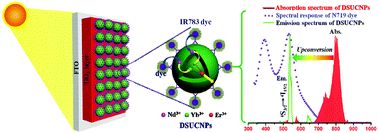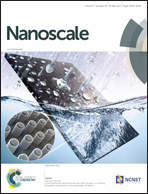Enhancing dye-sensitized solar cell efficiency through broadband near-infrared upconverting nanoparticles†
Abstract
The inability to utilize near infrared (NIR) light has posed a stringent limitation for the efficiencies of most single-junction photovoltaic cells such as dye-sensitized solar cells (DSSCs). Here, we describe a strategy to alleviate the NIR light harvesting problem by upconverting non-responsive NIR light in a broad spectral range (over 190 nm, 670–860 nm) to narrow solar-cell-responsive visible emissions through incorporated dye-sensitized upconversion nanoparticles (DSUCNPs). Unlike typically reported UCNPs with narrow and low NIR absorption, the organic dyes (IR783) anchored on the DSUCNP surface were able to harvest NIR photons broadly and efficiently, and then transfer the harvested energy to the inorganic UCNPs (typically reported), entailing an efficient visible upconversion. We show that the incorporation of DSUCNPs into the TiO2 photoanode of a DSSC is able to elevate its efficiency from 7.573% to 8.568%, enhancing the power conversion efficiency by about 13.1%. We quantified that among the relative efficiency increase, 7.1% arose from the contribution of broad-band upconversion in DSUCNPs (about ∼3.4 times higher than the highest previously reported value of ∼2.1%), and 6.0% mainly from the scattering effect of DSUCNPs. Our strategy has immediate implications for the use of DSUCNPs to improve the performance of other types of photovoltaic devices.



 Please wait while we load your content...
Please wait while we load your content...